Transform your garden boundaries with these seven elegant stone terracing options: tiered natural stone walls with cascading plants, Mediterranean dry stone terracing, Japanese Zen boundary stones, modern gabion baskets, rustic boulder terraces, integrated stone stairways, and layered fieldstone walls with perennials. These solutions combine aesthetic appeal with practical benefits like erosion control, improved drainage, and diverse planting opportunities. Each style creates distinct focal points while solving specific landscape challenges in your outdoor sanctuary.
Tiered Natural Stone Walls With Cascading Greenery
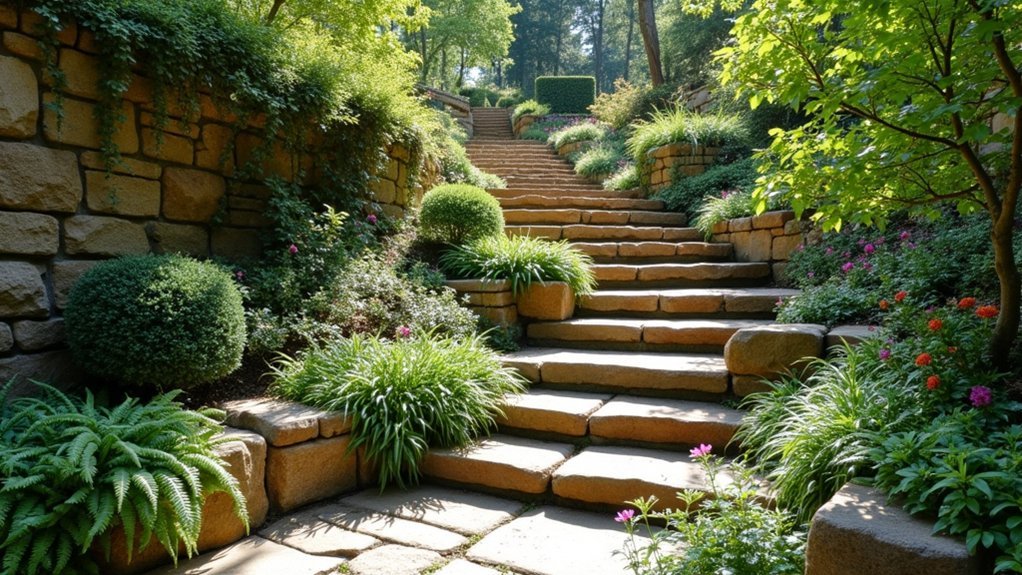
While traditional fences provide basic boundary solutions, tiered natural stone walls transform your garden’s edges into stunning focal points.
These structures offer exceptional structural support for sloped areas while creating an organic look with varying stone sizes and shapes.
Natural stone walls elegantly marry strength with beauty, transforming challenging slopes into artful landscape features.
You’ll appreciate how cascading greenery softens the walls’ hard edges, creating harmonious shifts between levels.
Incorporate planting pockets directly into the stone arrangement to showcase vibrant flowers and shrubs, adding color and texture throughout your terraced garden.
Beyond aesthetics, these natural stone boundaries promote effective drainage, preventing erosion and water accumulation.
This creates ideal conditions for diverse plant life to flourish at different levels.
Your garden boundary becomes not just a border but a living, breathing extension of your landscape design.
Mediterranean-Inspired Dry Stone Terracing
Mediterranean-inspired dry stone terracing offers a perfect canvas for rustic lavender borders that infuse your garden boundary with fragrance and a burst of purple hues.
You’ll find that these natural stone arrangements create ideal growing conditions for drought-tolerant Mediterranean herbs while providing structural definition to your outdoor space.
For a more substantial statement, consider incorporating olive grove terraces that evoke the sun-drenched hillsides of Greece and Italy, adding both visual interest and practical growing space to sloped areas of your property.
Rustic Lavender Borders
Combining ancient building techniques with fragrant flora, rustic lavender borders paired with dry stone terracing offer a breathtaking Mediterranean-inspired boundary solution for your garden. The porous structure of dry stone provides excellent drainage for lavender, which thrives in well-drained soil and full sun exposure. You’ll find this combination adds both stability and aesthetic appeal to sloped areas.
| Stone Type | Benefits | Best Lavender Companion |
|---|---|---|
| Limestone | Alkaline pH, natural look | English lavender |
| Slate | Modern texture, stability | French lavender |
| Sandstone | Warm colors, weathered charm | Spanish lavender |
Incorporate varying stone sizes to create dynamic textures throughout your terracing. This rustic approach not only supports your lavender plants but encourages biodiversity by attracting bees and butterflies. Your garden boundary becomes both a structural element and a vibrant ecosystem.
Olive Grove Terraces
Moving from lavender’s aromatic borders, another ancient boundary solution beckons from the hillsides of southern Europe. Olive grove terraces offer both functional boundaries and stunning landscape design elements that prevent soil erosion on sloped gardens.
You’ll appreciate how these dry stone structures allow natural drainage—essential for olive trees and other plantings. By incorporating local stones in traditional Mediterranean construction techniques, you’re creating sustainable boundaries that harmonize with your surroundings.
Enhance your terraces with native plants to boost biodiversity while creating visual appeal throughout the seasons. The beauty of this approach lies in its practicality—each carefully placed stone serves a purpose while contributing to the overall aesthetic.
These terraced boundaries don’t just divide space; they transform your garden into a picturesque landscape reminiscent of Mediterranean hillsides where function meets timeless beauty.
Japanese Zen Garden Boundary Stones
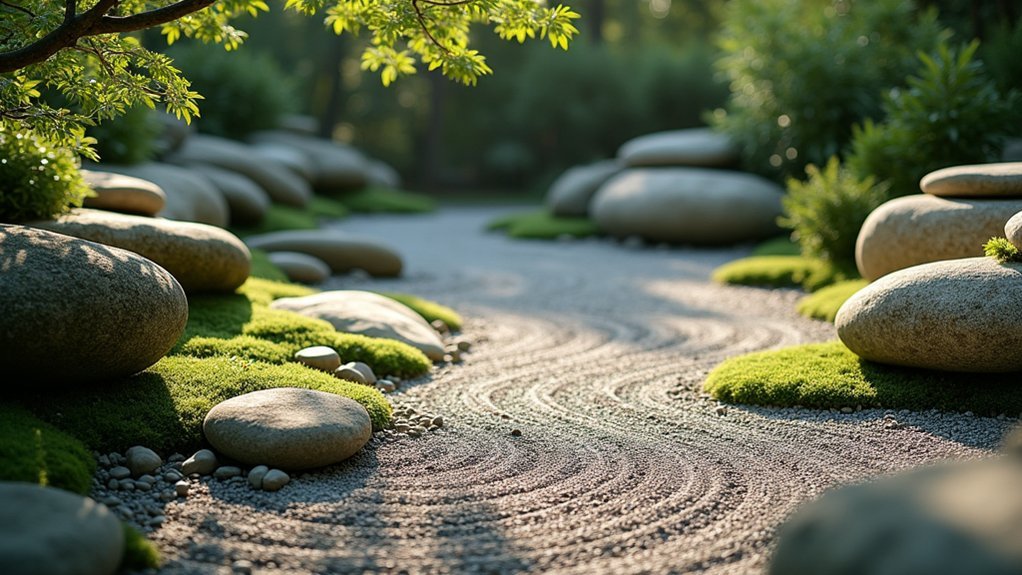
Japanese Zen garden boundary stones offer you a tranquil alternative to conventional borders through carefully arranged stacked stone meditation walls that create contemplative spaces within your landscape.
You’ll find weathered boulder pathways provide natural connections between garden areas while establishing subtle boundaries that guide movement and focus attention.
Moss-covered rock arrangements add texture and softness to your garden’s perimeter, creating a sense of age and permanence that invites reflection.
Stacked Stone Meditation Walls
While seeking tranquility in your outdoor space, stacked stone meditation walls offer an authentic way to embrace the principles of Zen garden design.
These low stone walls create defined boundaries that promote contemplation while maintaining open views throughout your garden landscape.
The dry-stacking construction technique not only showcases the natural beauty of each carefully selected stone but also provides practical drainage during rainfall.
You’ll find these serene barriers particularly effective at establishing a connection with nature when complemented by:
- Moss growth between stones for added texture
- Strategically placed plants to soften wall edges
- Stones with varied textures but complementary colors
- Gentle curves rather than rigid straight lines
Your stacked stone wall becomes more than a boundary—it transforms into a meditation focal point embodying Zen gardens’ simplicity and natural aesthetics.
Weathered Boulder Pathways
As you step beyond the meditation walls, weathered boulder pathways offer a distinctive approach to garden boundaries that seamlessly blend function with contemplative design. These textured stones create natural shifts while defining your garden’s borders with rustic aesthetic appeal.
You’ll find that strategic placement of these weathered boulders not only guides your journey through the space but also promotes natural drainage, preventing water pooling after rainfall.
| Benefit | Application | Effect |
|---|---|---|
| Visual interest | Border definition | Creates natural boundaries |
| Durability | Pathway material | Withstands weather elements |
| Water management | Natural drainage | Prevents garden flooding |
| Tactile experience | Walking surfaces | Enhances mindfulness |
| Habitat creation | Moss integration | Supports ground cover plants |
For authentic Zen gardens, complement your stone pathways with low-growing moss that softens edges while maintaining the tranquil atmosphere essential to contemplative outdoor spaces.
Moss-Covered Rock Arrangements
The ancient art of moss-covered rock arrangements draws from centuries of Japanese Zen tradition, transforming ordinary stones into boundary markers of profound spiritual significance.
You’ll find these natural boundaries bring tranquility to your garden while perfectly balancing beauty with function.
When designing your own moss-covered rock arrangements, consider:
- Embrace asymmetry and simplicity in placement to achieve authentic wabi-sabi aesthetics
- Select native moss species for an eco-friendly choice requiring minimal maintenance
- Position larger stones as anchors with smaller ones creating natural flow between spaces
- Layer different moss textures on weathered rocks to enhance visual depth
These living boundaries delineate garden spaces while inviting contemplation.
As moss slowly colonizes each carefully placed stone, your garden boundaries become increasingly integrated with the surrounding landscape, embodying nature’s patient artistry.
Gabion Basket Terracing for Modern Gardens
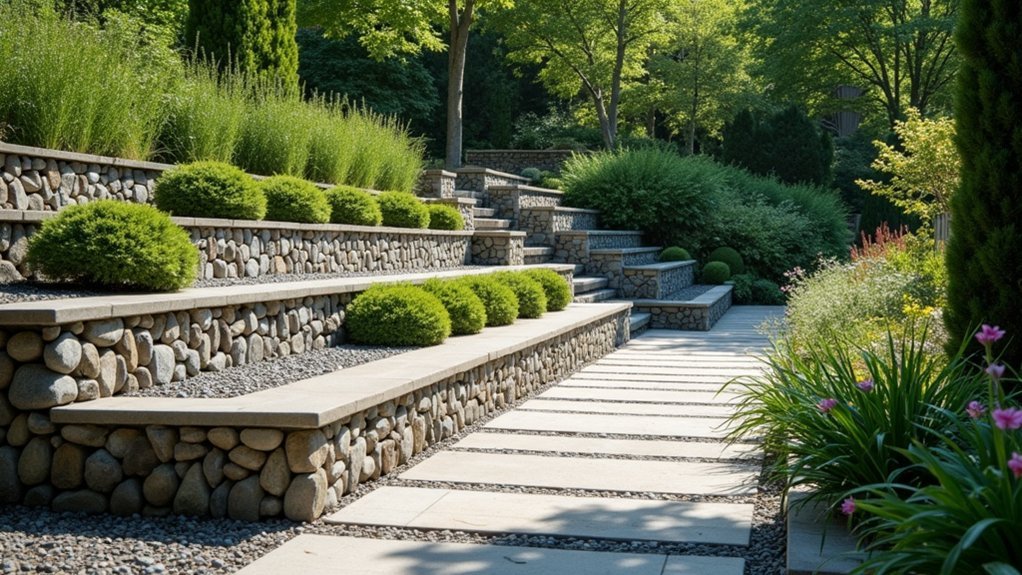
Modern gardens with sloping terrain can benefit tremendously from gabion basket terracing, a solution that combines functionality with contemporary style.
These wire mesh containers filled with stones create sturdy terraced boundaries that effectively manage slope stability while preventing soil erosion. You’ll appreciate how the gaps between stones allow for natural drainage, addressing water management concerns elegantly.
For a sustainable approach, fill your gabion wall with local materials or recycled stones that complement your garden’s existing palette.
Beyond their practical benefits, these structures establish tiered planting areas that maximize your garden space and accommodate diverse vegetation.
The contemporary aesthetic of gabion terracing integrates seamlessly with other landscape features, from winding pathways to cozy seating areas, resulting in cohesive outdoor spaces that are both beautiful and functional.
Rustic Boulder Terraces With Alpine Plantings
Creating rustic boulder terraces transforms sloping gardens into dramatic alpine-inspired sanctuaries while establishing clear natural boundaries.
These rugged hardscape elements not only manage challenging slopes but create a stunning visual boundary that blends seamlessly with your garden spaces.
The beauty of boulder terraces lies in their functionality and aesthetic appeal:
Boulder terraces offer that rare fusion of rugged utility and natural artistry, transforming ordinary slopes into extraordinary landscapes.
- Enhanced drainage – The natural gaps between boulders allow excess water to flow freely.
- Unique planting pockets – Crevices between stones create perfect homes for vibrant Primula, Dianthus, and thyme.
- Beneficial microclimates – Stones retain heat, protecting delicate alpine plantings during cooler seasons.
- Harmonious balance – The interplay between rough stone and delicate softscape elements creates visual interest.
You’ll appreciate how these terraces combine practicality with natural charm, creating a garden boundary that celebrates the rustic-refined contrast.
Integrated Stone Stairways in Terraced Boundaries
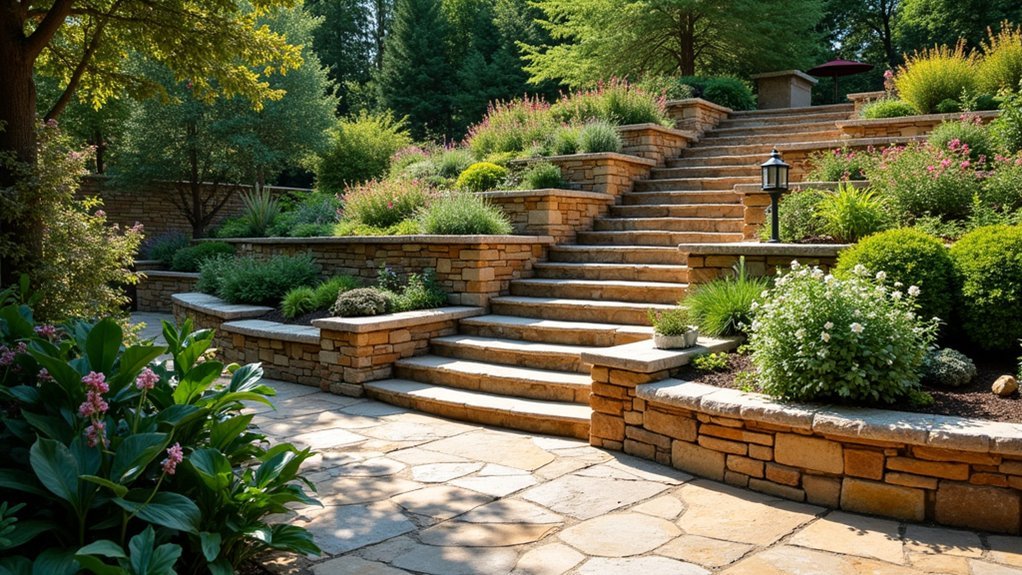
Within elegant terraced landscapes, integrated stone stairways offer far more than mere vertical passage – they serve as artful connectors that unite your garden’s various levels while reinforcing boundary definition. You’ll find these stone pathways prevent soil erosion and manage water drainage effectively, promoting healthier plant growth throughout your tiered garden.
| Stone Type | Benefits | Best Applications |
|---|---|---|
| Flagstone | Flat surface, natural slip resistance | Formal terraced gardens |
| Fieldstone | Rustic appearance, durability | Cottage-style boundaries |
| Bluestone | Elegant color, weather resistance | Contemporary designs |
| Limestone | Soft texture, uniform appearance | Mediterranean gardens |
| Granite | Maximum durability, bold texture | High-traffic areas |
Consider incorporating plant pockets alongside your stairways to soften the hardscape with strategic greenery, creating visual interest that elegantly blends functional pathways with your terraced boundary design.
Layered Fieldstone Walls With Flowering Perennials
While sophisticated in appearance, layered fieldstone walls offer one of the most versatile boundary solutions for gardens of any size or style.
These structures create a stunning terraced effect that provides essential support while enhancing your landscape’s natural rustic charm. You’ll find these walls particularly effective when topped with vibrant colors from flowering perennials like daylilies, coneflowers, and black-eyed Susans.
The benefits of this customizable design include:
Adaptable garden solutions that blend beauty and function while enhancing your landscape’s natural flow.
- Adaptable height options that conform to your specific garden topography
- Choice between dry-stacked or mortared fieldstones of varying shapes
- Creation of beneficial microclimates that support diverse plant growth
- Clear definition of garden boundaries while improving overall plant health
These terraced structures transform ordinary garden edges into stunning, functional landscape features that evolve beautifully with the seasons.
Frequently Asked Questions
How Much Does Professional Stone Terracing Typically Cost per Square Foot?
You’ll typically pay $25-$50 per square foot for professional stone terracing, depending on materials chosen, site accessibility, and labor costs in your area. Elaborate designs with premium stones cost more.
What Maintenance Is Required for Stone Terraced Gardens During Winter Months?
You’ll need minimal winter maintenance for stone terraced gardens. Clear debris and leaves, check for loose stones after freeze-thaw cycles, guarantee proper drainage, and remove snow carefully to prevent damage to delicate plants.
Can Stone Terracing Be Installed on Severely Sloped Properties?
Yes, you can install stone terracing on severely sloped properties. It’s actually ideal for steep grades, providing stability through proper engineering and drainage. You’ll need professional assessment to guarantee structural integrity and safety.
How Long Does a Properly Constructed Stone Terrace Garden Typically Last?
You’ll find that properly built stone terraces can last 50-100+ years with minimal maintenance. They’re incredibly durable when constructed with quality materials and proper drainage. Regular inspections will help guarantee their longevity for generations.
Are Permits Required for Building Tall Stone Garden Terraces?
You’ll typically need permits for tall stone garden terraces, especially those exceeding local height limits or affecting drainage. Check with your municipal building department as requirements vary by location and terrace dimensions.
In Summary
Stone terraced garden boundaries aren’t just functional—they’re stunning design features that transform your outdoor space. Whether you’ve chosen cascading greenery over natural stone or modern gabion baskets, you’ll enjoy both beauty and practicality. They’ll control erosion, maximize planting areas, and create visual interest while defining your garden’s edges. With proper installation, your stone terraced boundary will stand the test of time, becoming a cherished element of your landscape.

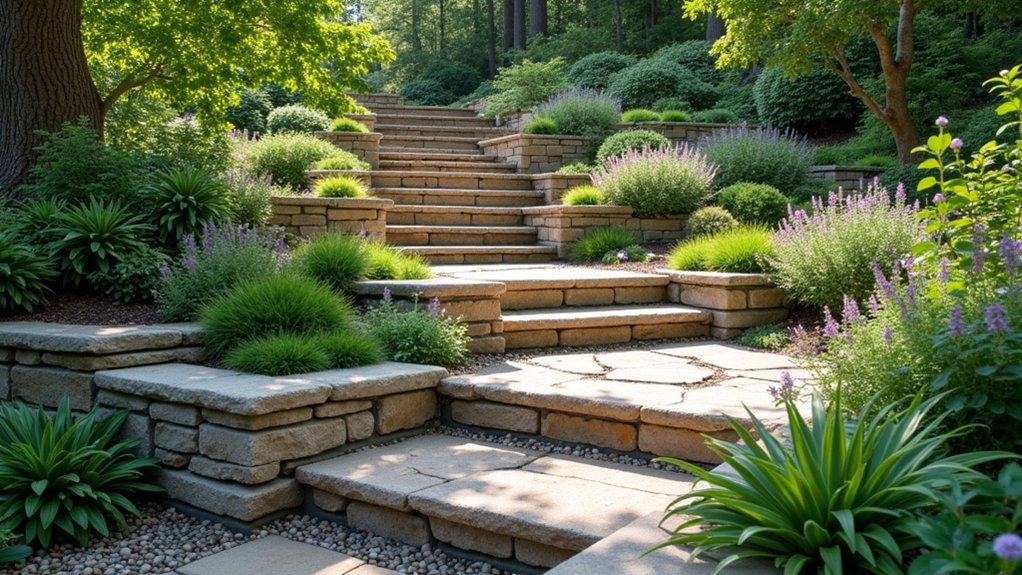



Leave a Reply